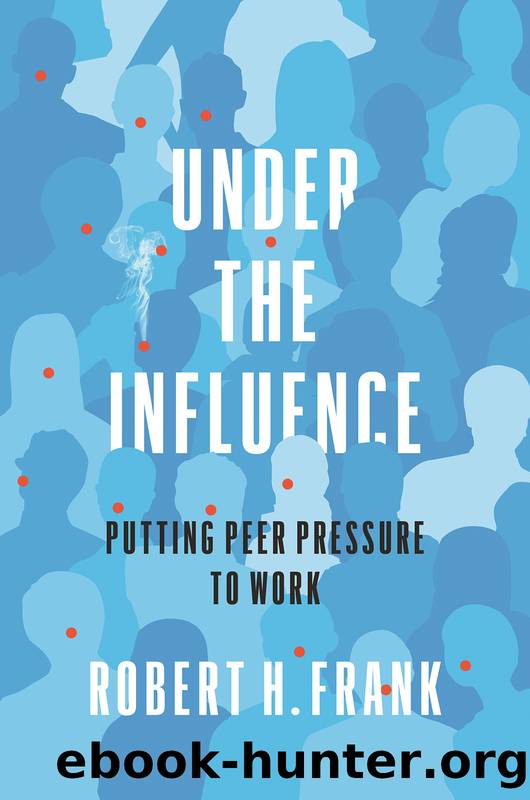Under the Influence by Robert H. Frank

Author:Robert H. Frank [Frank, Robert H.]
Language: eng
Format: epub
ISBN: 9780691193083
Publisher: PrincetonUP
Published: 2020-11-28T00:00:00+00:00
FIG. 9.5. Obesity and energy intake in the United States, 1961â2009. Adapted from CDC NHES and NHANES 1960â2008.
At monthâs end, canvassers collected data on electricity use for the four groups of homes. And sure enough, residents who had been told of neighborsâ conservation efforts showed by far the biggest reductions in electricity use levels.24 Discussing this experiment with the New York Times, Cialdini echoed a principal theme of this book: âWe think of ourselves as freestanding entities: âOh, Iâm independent of the influence of those around me. Iâm an individual.â In fact, we are swept by that information in ways we donât recognize.â25
In an experiment inspired by Cialdiniâs work, the economist Hunt Allcott designed a letter to electric utility customers living in comparison groups consisting of approximately one hundred houses with similar characteristics.26 The letter conveyed two messages. One was a list of concrete suggestions the homeowner could follow to reduce electricity consumption. The second message was a âsocial comparison moduleâ that gave the household one of three ratings based on a comparison of its electricity use with the usage of other homes in the same group. Those who used less electricity than the average of the most efficient quintile of homes received a rating of âGreat.â Those who used less than the average for all homes in the group got a rating of âGood,â while those who used more than the group average got a rating of âBelow Average.â
Under this scheme, all homes in the highest decile of a groupâs electricity consumption would of course receive a rating of âBelow Average.â Relative to their own preexperiment baselines, people living in these homes reduced their consumption by 6.3 percent. By contrast, homes in a groupâs lowest-usage decile all received a rating of âGreat.â Usage went down even in these homes, but perhaps because residents were already taking advantage of the most effective conservation strategies, consumption in this group fell only 0.3 percent.27
As noted earlier, behavioral contagion is evident in decisions to adopt photovoltaic solar panels. The marketing professor Bryan Bollinger and the economist Kenneth Gillingham employed statistical methods like the ones discussed in chapter 7 to assess whether peer effects influenced solar panel adoption in a large sample of houses in California. After controlling for a variety of potentially important confounding influences, they estimated an even larger impact than earlier researchers had found for tobacco and alcohol use: a 1 percent increase in a zip codeâs installed base of solar panels led to a slightly greater than 1 percent increase in the solar-panel adoption rate.28
In a similar study, Gillingham and the economist Marcello Graziano employed detailed data on solar installations in Connecticut. Here, too, adoption patterns exhibited considerable clustering that did not simply reflect causal influences like income. The probability that a homeowner in their sample would install solar panels was strongly influenced by the number of previously installed systems in the immediate vicinity. Consistent with the hypothesis of a contagion conveyed through social interaction and visibility, the authors found that the influence of nearby installations diminished with both distance and time.
Download
This site does not store any files on its server. We only index and link to content provided by other sites. Please contact the content providers to delete copyright contents if any and email us, we'll remove relevant links or contents immediately.
Einstein: His Life and Universe by Walter Isaacson(1314)
Finding Freedom: Harry and Meghan and the Making of a Modern Royal Family by Omid Scobie & Carolyn Durand(1175)
Promised Land (9781524763183) by Obama Barack(1154)
Compromised by Peter Strzok(1068)
Finding Freedom by Omid Scobie(1061)
JFK by Fredrik Logevall(993)
Freedom by Sebastian Junger(632)
Salford Lads: The Rise and Fall of Paul Massey by Bernard O'Mahoney(578)
The Russia House by John Le Carré(563)
Kremlin Winter by Robert Service(527)
Day of the Dead by Mark Roberts(514)
Graveyard (Ed & Lorraine Warren Book 1) by Ed Warren & Lorraine Warren & Robert David Chase(506)
A World Ablaze by Craig Harline(505)
Flying Tiger by Samson Jack(501)
Joe Biden: American Dreamer by Evan Osnos(491)
100 Things Successful Leaders Do by Nigel Cumberland(478)
Melania and Me: The Rise and Fall of My Friendship With the First Lady by Stephanie Winston Wolkoff(476)
The Irish Buddhist by Alicia Turner(472)
The Mission by David W. Brown(459)
